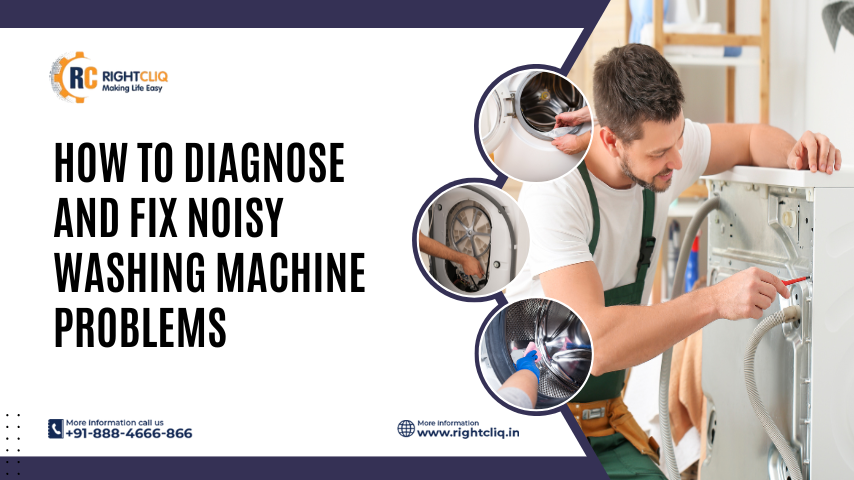How to Diagnose and Fix Noisy Washing Machine Problems

Effective Solutions to Reduce Washing Machine Noise Issues
A noisy washing machine can bring disruption to daily life; however, well-maintained appliances work smoothly. Well installed, with a sound drum and good bearings, they perform effectively. If the things done with the right approach, the washing machine repair becomes easy peasy without making way for long term damage. Smart ideas and regular maintenance help to extend the lifetime of your appliances. Starting with common reasons for noisy washing machine problems and using sensible DIY methods, this simple and beginner-friendly enthusiastic guide will show you how to fix a noisy washing machine at home. A few simple tweaks guarantee flawless operation and quiet and smooth every spin.
What Is Behind Your Noisy Washing Machine
A noisy washing machine can make laundry a frustrating experience. Typical reasons for this problem may include bad bearings, unbalanced loads, faulty shock absorbers, and blocked pumping drains.
Such models often use components such as belts and motors that can wear down over time, leading to increased noise as they run. Without addressing these issues, they often receive more destruction and expensive repairs. You need to treat these early warning signs ASAP to prevent costly repairs later.
A simple validation of your equipment during its use can reveal the cause of the sound and quickly resolve the issue. Like any appliance, regular upkeep helps to keep your washing machine running smoothly. Some minor tweaks and repairs can give it back its quiet, smooth operation, making laundry cycles significantly more peaceful.
Easy Home Repair to Silence Your Noisy Washing Machine
A noisy washing machine can disturb your peace, but a handful of easy home repairs can return it to quiet operation.
Be sure to level the machine — adjust the feet to minimize unwanted vibrations.
Check the drum bearings, since worn bearings make a rumbling noise.
Tighten loose screws, and extract any foreign debris — coins, buttons, etc. — lodged in the drum.
If you hear squeaking, the belt may need to be adjusted or replaced.
Over-bouncing check on shock absorbers and suspension rods.
Getting regular maintenance done (cleaning the drain pump and filter) can prevent the problem from occurring again. When noise continues in spite of DIY, it’s time for washing machine repair by the pros. Now with these simple steps your appliance will be running perfectly and the laundry cycle is peaceful again.
Hidden Enemies: The Little Things That Make a Lot of Noise
There could be disruptive noises in your "noisy washing machine" from several small but important parts inside.
While a broken belt causes high-pitched squeaks, worn-out bearings sometimes generate deep rumbling noises. Over time, shock absorbers and suspension rods fail, resulting in too much drum movement. Worn-out motor brushes are another possible cause of grinding sounds.
Early resolution of such insignificant issues helps to avoid more costly washing machine repairs. Changes of small parts at the right time make sure your machine runs smoothly and stays functional for a long time.
The Balancing Act: Stop the Shaking
The most common cause of excessive shaking is an unbalanced noisy washing machine. If you overload or irregularly spread clothing inside the drum, it causes vibrations.
Adhere to manufacturer’s weight guidelines and ensure laundry is balanced evenly. If the machine shakes during a spin cycle, its feet need adjustment for proper leveling. Placing anti-vibration pads under the washing machine also helps mitigate shocks.
Inspecting suspension rods and dampers to suppress further imbalances. Your washing machine needs to be well-balanced to be able to do your laundry without vibrations.
Cunning Maintenance: How to Quiet the Noise Forever
A washing machine's smooth operation over the years depends mostly on regular maintenance.
→ To stop dirt formation, clean the filter, detergent drawer, and drum.
→ Check connections and hoses to prevent leaks that can produce internal noises.
→ Lubricate them to lower friction and increase the lifetime of moving elements like bearings and pulleys.
→ Running a washing machine cleaner or vinegar-based empty hot water cycle eliminates limescale and detergent residue.
These basic steps ensure the quiet and effective running of every cycle, avoiding expensive washing machine repair.
Final Spin: Enjoy a Smooth and Silent Laundry Experience
A noisy washing machine is a common problem, but making the necessary changes now can prevent more significant issues in the future. From balancing the load or changing worn parts to keeping on a regular maintenance routine, these simple start-ups will ensure your washer runs quietly and quickly. If you have done all of that and the noise continues, it might be time to call the pros. While DIY solutions can be limiting, professional servicing is the best way to navigate the issue.
From the desk of Rightcliq:
Regarding the fixes for your related issues, Rightcliq is there. Rightcliq offers professional repair services if your machine is not performing well. And its experienced professionals can find and resolve any underlying issues for smooth, quiet operation. Are you tired of listening to a loud washing machine while doing your laundry? Call Rightcliq today for a noise-free and hassle-free laundry experience that will keep your appliances running smoothly for many years!















